Management Economics Assessment 2
VerifiedAdded on 2023/06/18
|11
|3193
|231
AI Summary
The report evaluates economic data as guide to policy making in the company and analyses impact of government policy on managerial decisions. It highlights description of the business, analysis of market and different market structure. It is suggested that the government should intervene to a lesser extent.
Contribute Materials
Your contribution can guide someone’s learning journey. Share your
documents today.
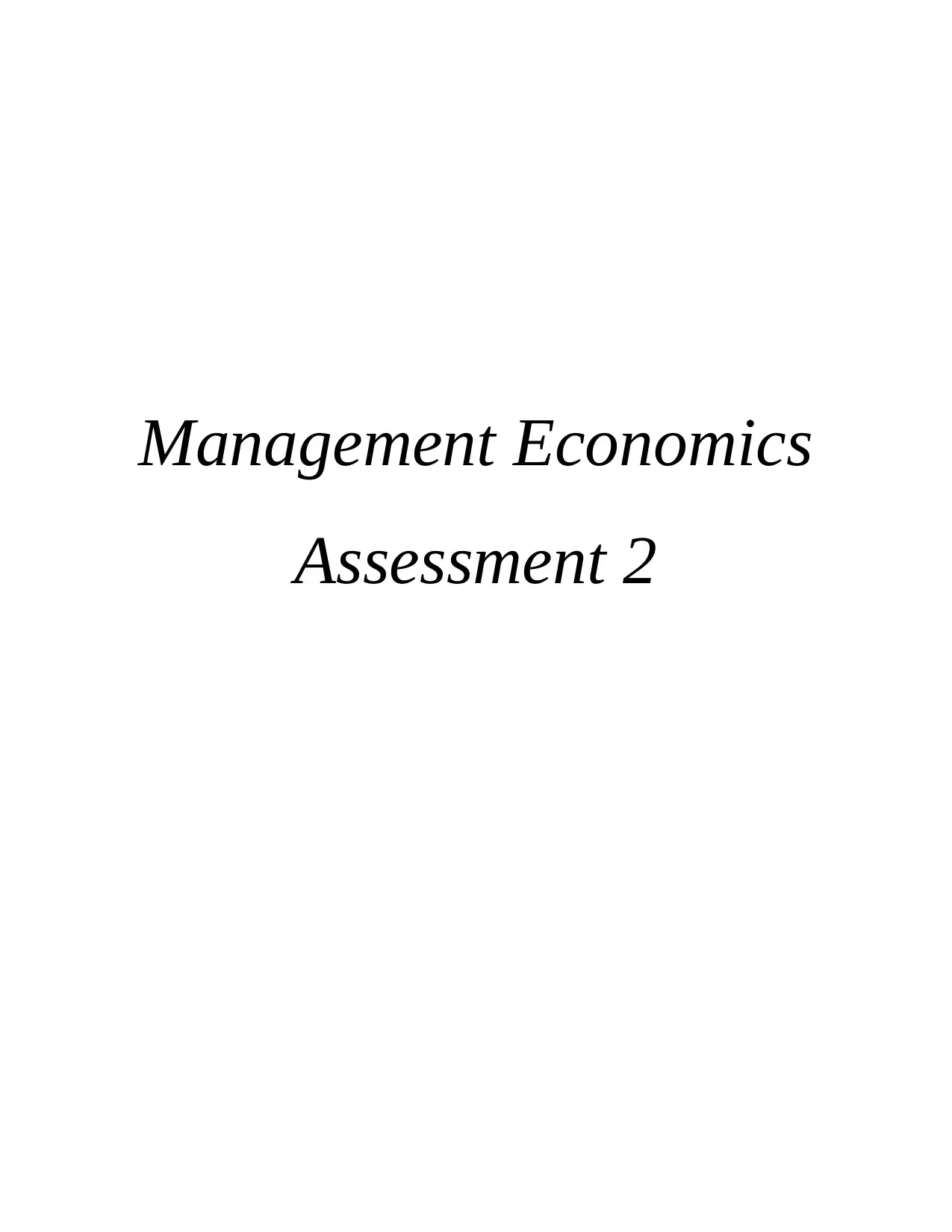
Management Economics
Assessment 2
Assessment 2
Secure Best Marks with AI Grader
Need help grading? Try our AI Grader for instant feedback on your assignments.
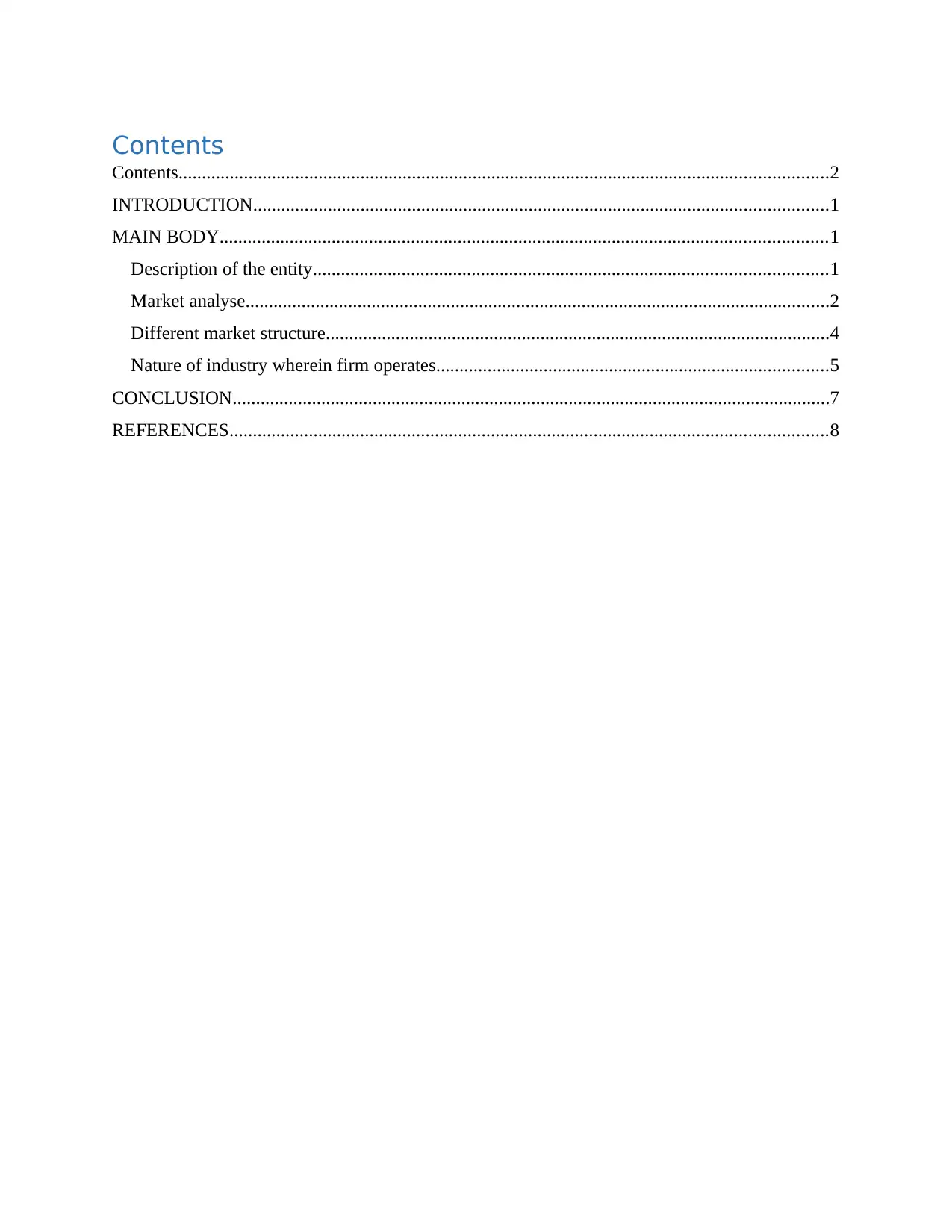
Contents
Contents...........................................................................................................................................2
INTRODUCTION...........................................................................................................................1
MAIN BODY..................................................................................................................................1
Description of the entity..............................................................................................................1
Market analyse.............................................................................................................................2
Different market structure............................................................................................................4
Nature of industry wherein firm operates....................................................................................5
CONCLUSION................................................................................................................................7
REFERENCES................................................................................................................................8
Contents...........................................................................................................................................2
INTRODUCTION...........................................................................................................................1
MAIN BODY..................................................................................................................................1
Description of the entity..............................................................................................................1
Market analyse.............................................................................................................................2
Different market structure............................................................................................................4
Nature of industry wherein firm operates....................................................................................5
CONCLUSION................................................................................................................................7
REFERENCES................................................................................................................................8
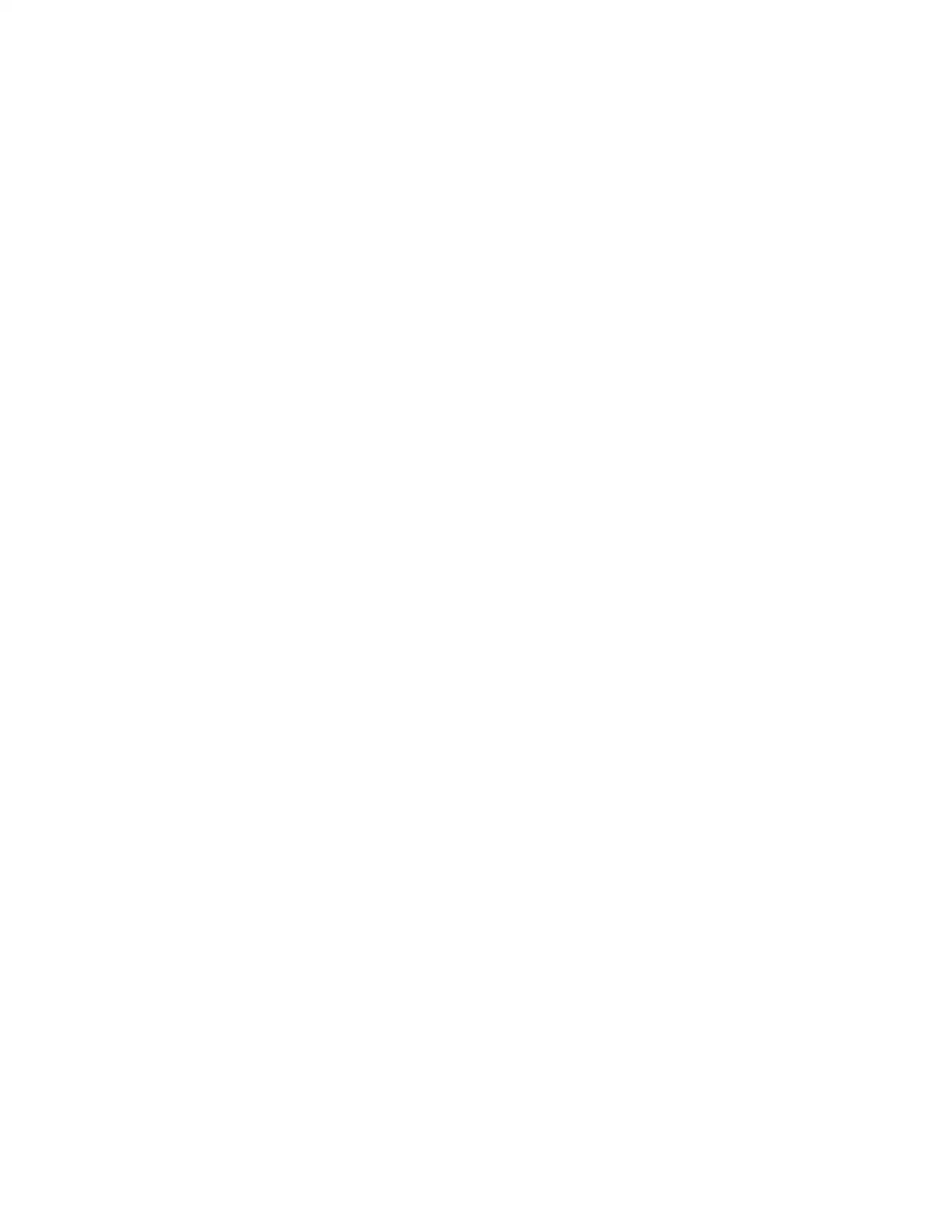
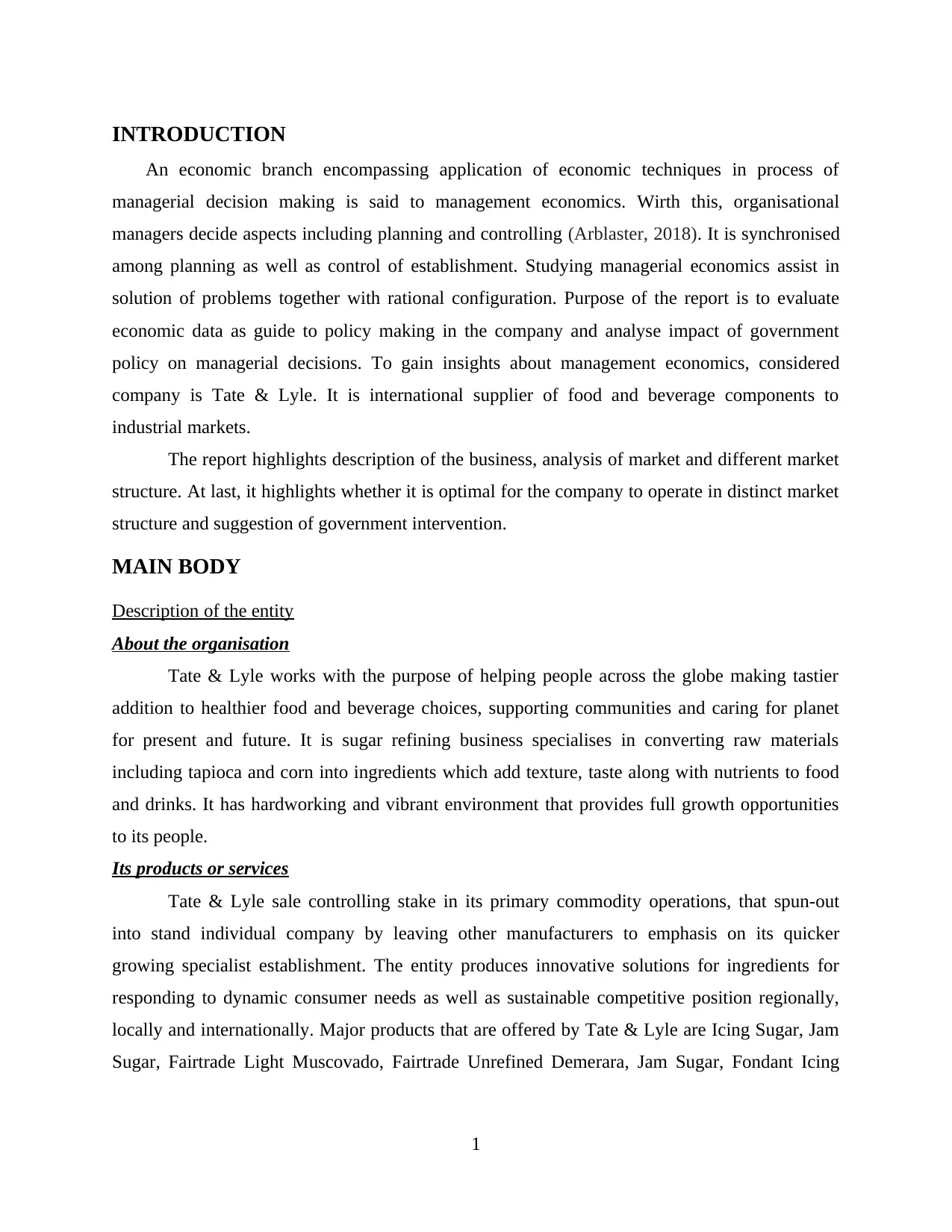
INTRODUCTION
An economic branch encompassing application of economic techniques in process of
managerial decision making is said to management economics. Wirth this, organisational
managers decide aspects including planning and controlling (Arblaster, 2018). It is synchronised
among planning as well as control of establishment. Studying managerial economics assist in
solution of problems together with rational configuration. Purpose of the report is to evaluate
economic data as guide to policy making in the company and analyse impact of government
policy on managerial decisions. To gain insights about management economics, considered
company is Tate & Lyle. It is international supplier of food and beverage components to
industrial markets.
The report highlights description of the business, analysis of market and different market
structure. At last, it highlights whether it is optimal for the company to operate in distinct market
structure and suggestion of government intervention.
MAIN BODY
Description of the entity
About the organisation
Tate & Lyle works with the purpose of helping people across the globe making tastier
addition to healthier food and beverage choices, supporting communities and caring for planet
for present and future. It is sugar refining business specialises in converting raw materials
including tapioca and corn into ingredients which add texture, taste along with nutrients to food
and drinks. It has hardworking and vibrant environment that provides full growth opportunities
to its people.
Its products or services
Tate & Lyle sale controlling stake in its primary commodity operations, that spun-out
into stand individual company by leaving other manufacturers to emphasis on its quicker
growing specialist establishment. The entity produces innovative solutions for ingredients for
responding to dynamic consumer needs as well as sustainable competitive position regionally,
locally and internationally. Major products that are offered by Tate & Lyle are Icing Sugar, Jam
Sugar, Fairtrade Light Muscovado, Fairtrade Unrefined Demerara, Jam Sugar, Fondant Icing
1
An economic branch encompassing application of economic techniques in process of
managerial decision making is said to management economics. Wirth this, organisational
managers decide aspects including planning and controlling (Arblaster, 2018). It is synchronised
among planning as well as control of establishment. Studying managerial economics assist in
solution of problems together with rational configuration. Purpose of the report is to evaluate
economic data as guide to policy making in the company and analyse impact of government
policy on managerial decisions. To gain insights about management economics, considered
company is Tate & Lyle. It is international supplier of food and beverage components to
industrial markets.
The report highlights description of the business, analysis of market and different market
structure. At last, it highlights whether it is optimal for the company to operate in distinct market
structure and suggestion of government intervention.
MAIN BODY
Description of the entity
About the organisation
Tate & Lyle works with the purpose of helping people across the globe making tastier
addition to healthier food and beverage choices, supporting communities and caring for planet
for present and future. It is sugar refining business specialises in converting raw materials
including tapioca and corn into ingredients which add texture, taste along with nutrients to food
and drinks. It has hardworking and vibrant environment that provides full growth opportunities
to its people.
Its products or services
Tate & Lyle sale controlling stake in its primary commodity operations, that spun-out
into stand individual company by leaving other manufacturers to emphasis on its quicker
growing specialist establishment. The entity produces innovative solutions for ingredients for
responding to dynamic consumer needs as well as sustainable competitive position regionally,
locally and internationally. Major products that are offered by Tate & Lyle are Icing Sugar, Jam
Sugar, Fairtrade Light Muscovado, Fairtrade Unrefined Demerara, Jam Sugar, Fondant Icing
1
Secure Best Marks with AI Grader
Need help grading? Try our AI Grader for instant feedback on your assignments.
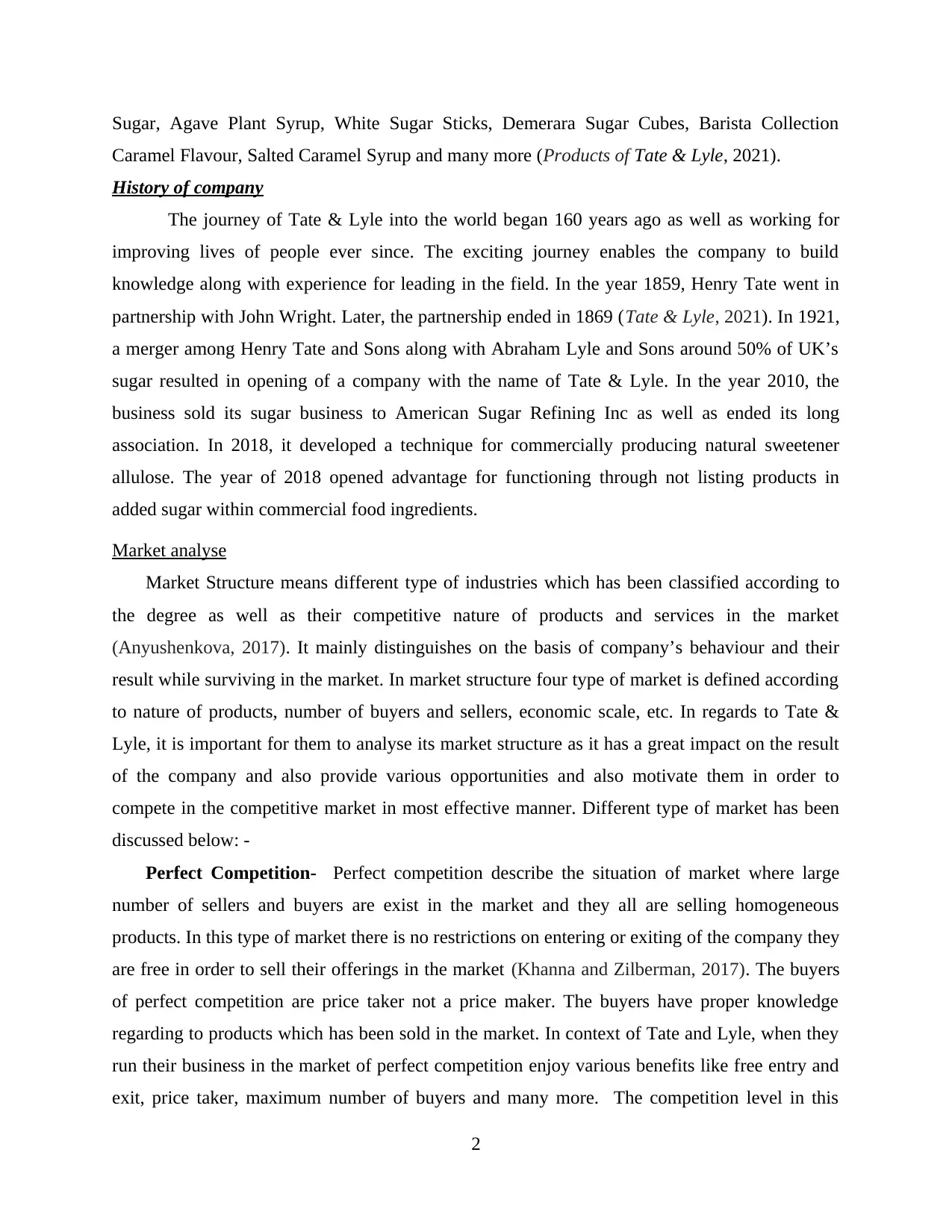
Sugar, Agave Plant Syrup, White Sugar Sticks, Demerara Sugar Cubes, Barista Collection
Caramel Flavour, Salted Caramel Syrup and many more (Products of Tate & Lyle, 2021).
History of company
The journey of Tate & Lyle into the world began 160 years ago as well as working for
improving lives of people ever since. The exciting journey enables the company to build
knowledge along with experience for leading in the field. In the year 1859, Henry Tate went in
partnership with John Wright. Later, the partnership ended in 1869 (Tate & Lyle, 2021). In 1921,
a merger among Henry Tate and Sons along with Abraham Lyle and Sons around 50% of UK’s
sugar resulted in opening of a company with the name of Tate & Lyle. In the year 2010, the
business sold its sugar business to American Sugar Refining Inc as well as ended its long
association. In 2018, it developed a technique for commercially producing natural sweetener
allulose. The year of 2018 opened advantage for functioning through not listing products in
added sugar within commercial food ingredients.
Market analyse
Market Structure means different type of industries which has been classified according to
the degree as well as their competitive nature of products and services in the market
(Anyushenkova, 2017). It mainly distinguishes on the basis of company’s behaviour and their
result while surviving in the market. In market structure four type of market is defined according
to nature of products, number of buyers and sellers, economic scale, etc. In regards to Tate &
Lyle, it is important for them to analyse its market structure as it has a great impact on the result
of the company and also provide various opportunities and also motivate them in order to
compete in the competitive market in most effective manner. Different type of market has been
discussed below: -
Perfect Competition- Perfect competition describe the situation of market where large
number of sellers and buyers are exist in the market and they all are selling homogeneous
products. In this type of market there is no restrictions on entering or exiting of the company they
are free in order to sell their offerings in the market (Khanna and Zilberman, 2017). The buyers
of perfect competition are price taker not a price maker. The buyers have proper knowledge
regarding to products which has been sold in the market. In context of Tate and Lyle, when they
run their business in the market of perfect competition enjoy various benefits like free entry and
exit, price taker, maximum number of buyers and many more. The competition level in this
2
Caramel Flavour, Salted Caramel Syrup and many more (Products of Tate & Lyle, 2021).
History of company
The journey of Tate & Lyle into the world began 160 years ago as well as working for
improving lives of people ever since. The exciting journey enables the company to build
knowledge along with experience for leading in the field. In the year 1859, Henry Tate went in
partnership with John Wright. Later, the partnership ended in 1869 (Tate & Lyle, 2021). In 1921,
a merger among Henry Tate and Sons along with Abraham Lyle and Sons around 50% of UK’s
sugar resulted in opening of a company with the name of Tate & Lyle. In the year 2010, the
business sold its sugar business to American Sugar Refining Inc as well as ended its long
association. In 2018, it developed a technique for commercially producing natural sweetener
allulose. The year of 2018 opened advantage for functioning through not listing products in
added sugar within commercial food ingredients.
Market analyse
Market Structure means different type of industries which has been classified according to
the degree as well as their competitive nature of products and services in the market
(Anyushenkova, 2017). It mainly distinguishes on the basis of company’s behaviour and their
result while surviving in the market. In market structure four type of market is defined according
to nature of products, number of buyers and sellers, economic scale, etc. In regards to Tate &
Lyle, it is important for them to analyse its market structure as it has a great impact on the result
of the company and also provide various opportunities and also motivate them in order to
compete in the competitive market in most effective manner. Different type of market has been
discussed below: -
Perfect Competition- Perfect competition describe the situation of market where large
number of sellers and buyers are exist in the market and they all are selling homogeneous
products. In this type of market there is no restrictions on entering or exiting of the company they
are free in order to sell their offerings in the market (Khanna and Zilberman, 2017). The buyers
of perfect competition are price taker not a price maker. The buyers have proper knowledge
regarding to products which has been sold in the market. In context of Tate and Lyle, when they
run their business in the market of perfect competition enjoy various benefits like free entry and
exit, price taker, maximum number of buyers and many more. The competition level in this
2
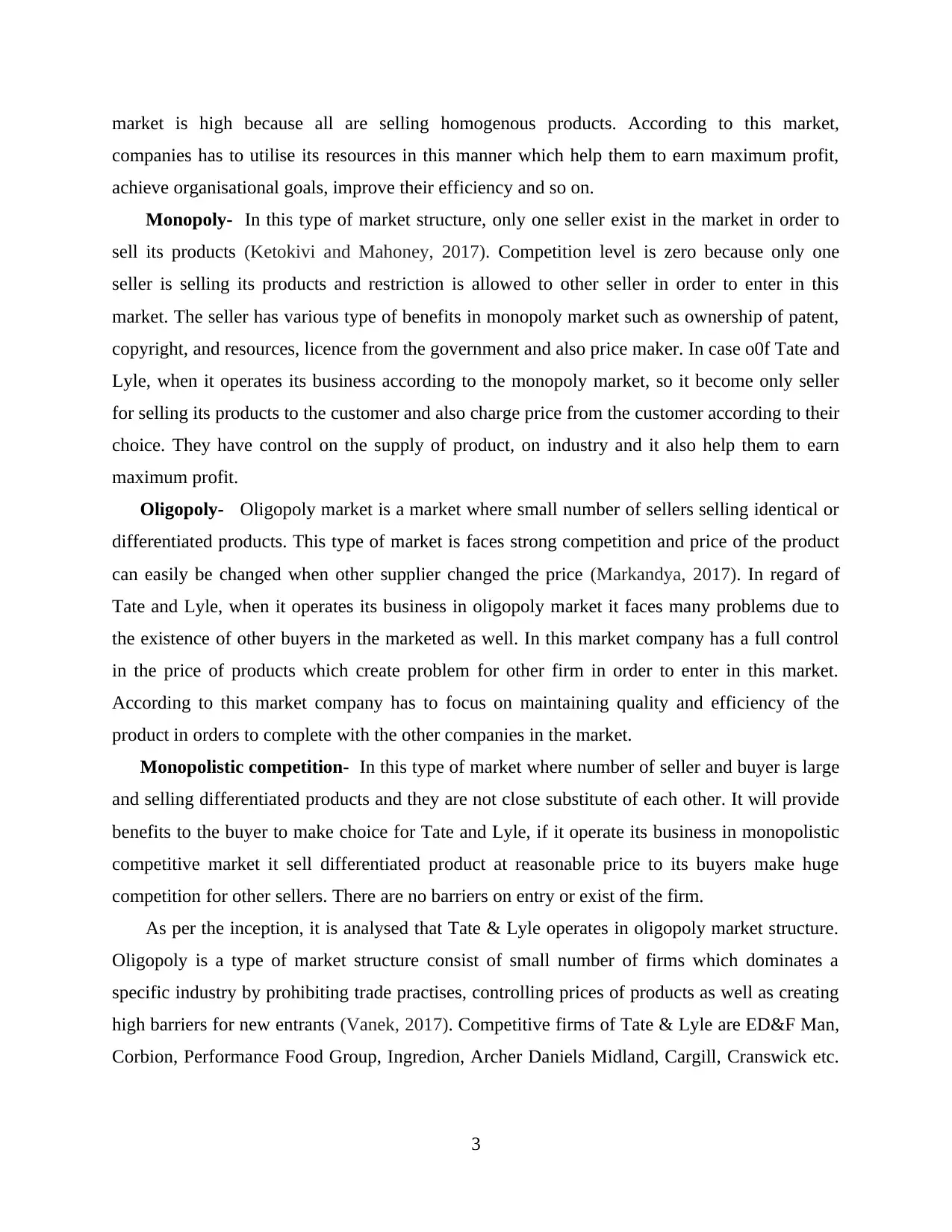
market is high because all are selling homogenous products. According to this market,
companies has to utilise its resources in this manner which help them to earn maximum profit,
achieve organisational goals, improve their efficiency and so on.
Monopoly- In this type of market structure, only one seller exist in the market in order to
sell its products (Ketokivi and Mahoney, 2017). Competition level is zero because only one
seller is selling its products and restriction is allowed to other seller in order to enter in this
market. The seller has various type of benefits in monopoly market such as ownership of patent,
copyright, and resources, licence from the government and also price maker. In case o0f Tate and
Lyle, when it operates its business according to the monopoly market, so it become only seller
for selling its products to the customer and also charge price from the customer according to their
choice. They have control on the supply of product, on industry and it also help them to earn
maximum profit.
Oligopoly- Oligopoly market is a market where small number of sellers selling identical or
differentiated products. This type of market is faces strong competition and price of the product
can easily be changed when other supplier changed the price (Markandya, 2017). In regard of
Tate and Lyle, when it operates its business in oligopoly market it faces many problems due to
the existence of other buyers in the marketed as well. In this market company has a full control
in the price of products which create problem for other firm in order to enter in this market.
According to this market company has to focus on maintaining quality and efficiency of the
product in orders to complete with the other companies in the market.
Monopolistic competition- In this type of market where number of seller and buyer is large
and selling differentiated products and they are not close substitute of each other. It will provide
benefits to the buyer to make choice for Tate and Lyle, if it operate its business in monopolistic
competitive market it sell differentiated product at reasonable price to its buyers make huge
competition for other sellers. There are no barriers on entry or exist of the firm.
As per the inception, it is analysed that Tate & Lyle operates in oligopoly market structure.
Oligopoly is a type of market structure consist of small number of firms which dominates a
specific industry by prohibiting trade practises, controlling prices of products as well as creating
high barriers for new entrants (Vanek, 2017). Competitive firms of Tate & Lyle are ED&F Man,
Corbion, Performance Food Group, Ingredion, Archer Daniels Midland, Cargill, Cranswick etc.
3
companies has to utilise its resources in this manner which help them to earn maximum profit,
achieve organisational goals, improve their efficiency and so on.
Monopoly- In this type of market structure, only one seller exist in the market in order to
sell its products (Ketokivi and Mahoney, 2017). Competition level is zero because only one
seller is selling its products and restriction is allowed to other seller in order to enter in this
market. The seller has various type of benefits in monopoly market such as ownership of patent,
copyright, and resources, licence from the government and also price maker. In case o0f Tate and
Lyle, when it operates its business according to the monopoly market, so it become only seller
for selling its products to the customer and also charge price from the customer according to their
choice. They have control on the supply of product, on industry and it also help them to earn
maximum profit.
Oligopoly- Oligopoly market is a market where small number of sellers selling identical or
differentiated products. This type of market is faces strong competition and price of the product
can easily be changed when other supplier changed the price (Markandya, 2017). In regard of
Tate and Lyle, when it operates its business in oligopoly market it faces many problems due to
the existence of other buyers in the marketed as well. In this market company has a full control
in the price of products which create problem for other firm in order to enter in this market.
According to this market company has to focus on maintaining quality and efficiency of the
product in orders to complete with the other companies in the market.
Monopolistic competition- In this type of market where number of seller and buyer is large
and selling differentiated products and they are not close substitute of each other. It will provide
benefits to the buyer to make choice for Tate and Lyle, if it operate its business in monopolistic
competitive market it sell differentiated product at reasonable price to its buyers make huge
competition for other sellers. There are no barriers on entry or exist of the firm.
As per the inception, it is analysed that Tate & Lyle operates in oligopoly market structure.
Oligopoly is a type of market structure consist of small number of firms which dominates a
specific industry by prohibiting trade practises, controlling prices of products as well as creating
high barriers for new entrants (Vanek, 2017). Competitive firms of Tate & Lyle are ED&F Man,
Corbion, Performance Food Group, Ingredion, Archer Daniels Midland, Cargill, Cranswick etc.
3
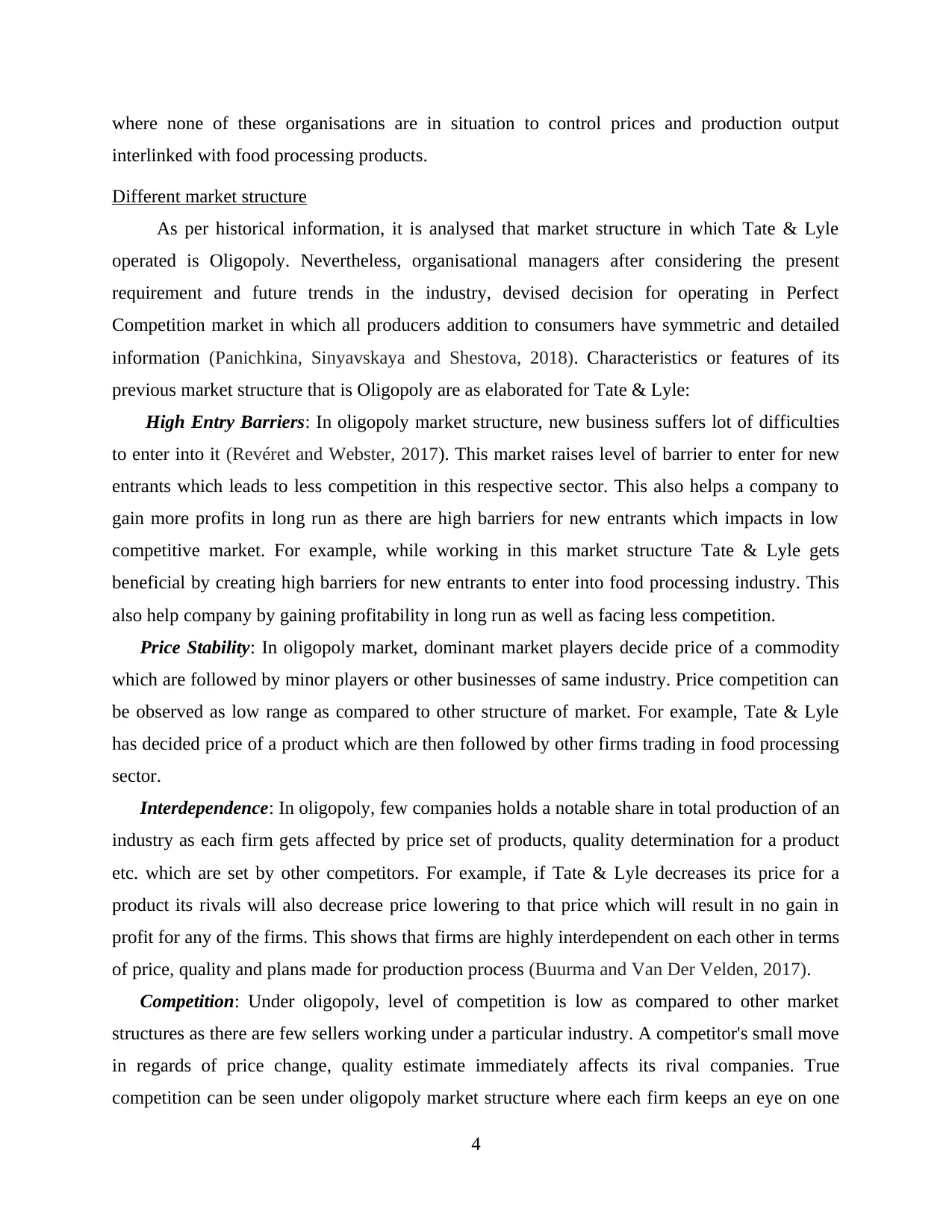
where none of these organisations are in situation to control prices and production output
interlinked with food processing products.
Different market structure
As per historical information, it is analysed that market structure in which Tate & Lyle
operated is Oligopoly. Nevertheless, organisational managers after considering the present
requirement and future trends in the industry, devised decision for operating in Perfect
Competition market in which all producers addition to consumers have symmetric and detailed
information (Panichkina, Sinyavskaya and Shestova, 2018). Characteristics or features of its
previous market structure that is Oligopoly are as elaborated for Tate & Lyle:
High Entry Barriers: In oligopoly market structure, new business suffers lot of difficulties
to enter into it (Revéret and Webster, 2017). This market raises level of barrier to enter for new
entrants which leads to less competition in this respective sector. This also helps a company to
gain more profits in long run as there are high barriers for new entrants which impacts in low
competitive market. For example, while working in this market structure Tate & Lyle gets
beneficial by creating high barriers for new entrants to enter into food processing industry. This
also help company by gaining profitability in long run as well as facing less competition.
Price Stability: In oligopoly market, dominant market players decide price of a commodity
which are followed by minor players or other businesses of same industry. Price competition can
be observed as low range as compared to other structure of market. For example, Tate & Lyle
has decided price of a product which are then followed by other firms trading in food processing
sector.
Interdependence: In oligopoly, few companies holds a notable share in total production of an
industry as each firm gets affected by price set of products, quality determination for a product
etc. which are set by other competitors. For example, if Tate & Lyle decreases its price for a
product its rivals will also decrease price lowering to that price which will result in no gain in
profit for any of the firms. This shows that firms are highly interdependent on each other in terms
of price, quality and plans made for production process (Buurma and Van Der Velden, 2017).
Competition: Under oligopoly, level of competition is low as compared to other market
structures as there are few sellers working under a particular industry. A competitor's small move
in regards of price change, quality estimate immediately affects its rival companies. True
competition can be seen under oligopoly market structure where each firm keeps an eye on one
4
interlinked with food processing products.
Different market structure
As per historical information, it is analysed that market structure in which Tate & Lyle
operated is Oligopoly. Nevertheless, organisational managers after considering the present
requirement and future trends in the industry, devised decision for operating in Perfect
Competition market in which all producers addition to consumers have symmetric and detailed
information (Panichkina, Sinyavskaya and Shestova, 2018). Characteristics or features of its
previous market structure that is Oligopoly are as elaborated for Tate & Lyle:
High Entry Barriers: In oligopoly market structure, new business suffers lot of difficulties
to enter into it (Revéret and Webster, 2017). This market raises level of barrier to enter for new
entrants which leads to less competition in this respective sector. This also helps a company to
gain more profits in long run as there are high barriers for new entrants which impacts in low
competitive market. For example, while working in this market structure Tate & Lyle gets
beneficial by creating high barriers for new entrants to enter into food processing industry. This
also help company by gaining profitability in long run as well as facing less competition.
Price Stability: In oligopoly market, dominant market players decide price of a commodity
which are followed by minor players or other businesses of same industry. Price competition can
be observed as low range as compared to other structure of market. For example, Tate & Lyle
has decided price of a product which are then followed by other firms trading in food processing
sector.
Interdependence: In oligopoly, few companies holds a notable share in total production of an
industry as each firm gets affected by price set of products, quality determination for a product
etc. which are set by other competitors. For example, if Tate & Lyle decreases its price for a
product its rivals will also decrease price lowering to that price which will result in no gain in
profit for any of the firms. This shows that firms are highly interdependent on each other in terms
of price, quality and plans made for production process (Buurma and Van Der Velden, 2017).
Competition: Under oligopoly, level of competition is low as compared to other market
structures as there are few sellers working under a particular industry. A competitor's small move
in regards of price change, quality estimate immediately affects its rival companies. True
competition can be seen under oligopoly market structure where each firm keeps an eye on one
4
Paraphrase This Document
Need a fresh take? Get an instant paraphrase of this document with our AI Paraphraser
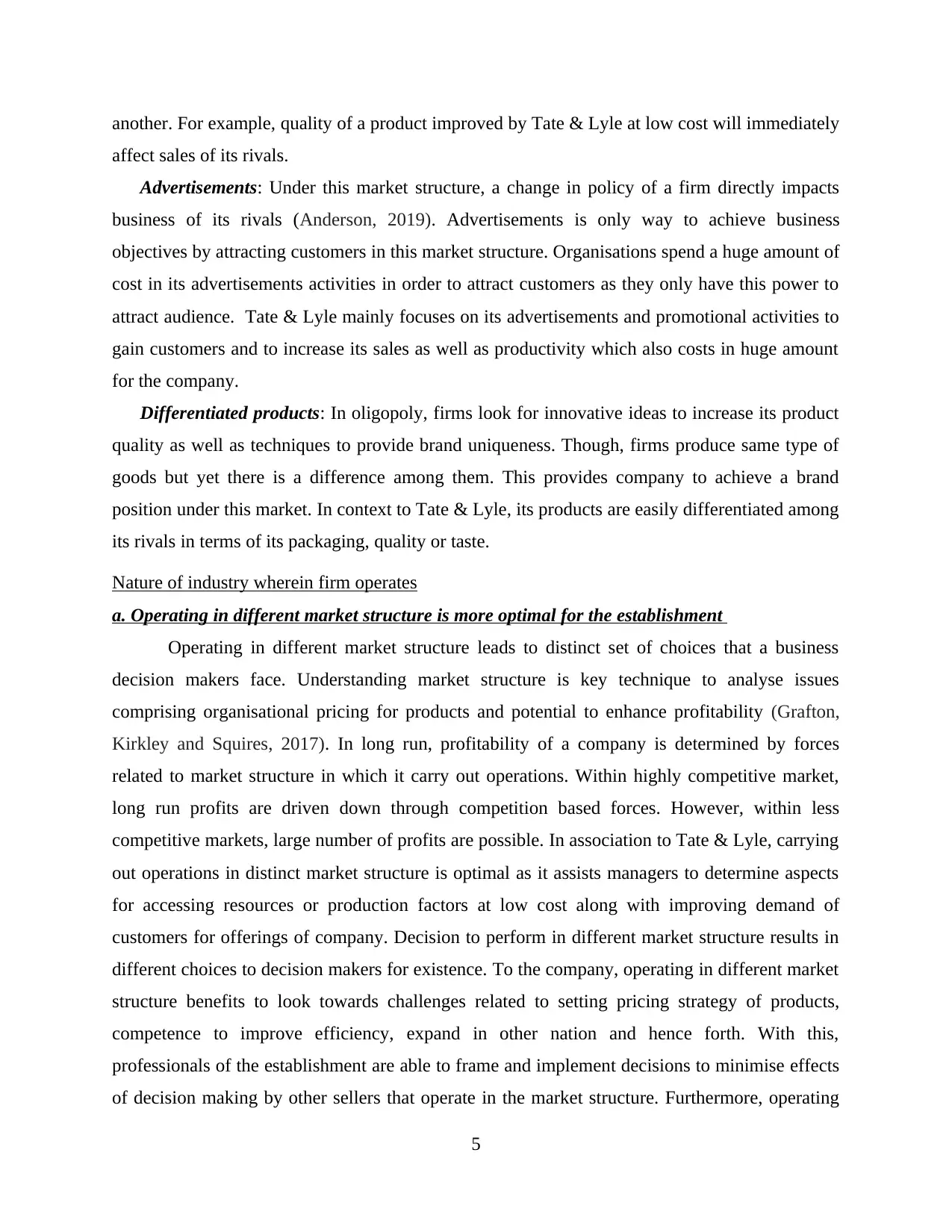
another. For example, quality of a product improved by Tate & Lyle at low cost will immediately
affect sales of its rivals.
Advertisements: Under this market structure, a change in policy of a firm directly impacts
business of its rivals (Anderson, 2019). Advertisements is only way to achieve business
objectives by attracting customers in this market structure. Organisations spend a huge amount of
cost in its advertisements activities in order to attract customers as they only have this power to
attract audience. Tate & Lyle mainly focuses on its advertisements and promotional activities to
gain customers and to increase its sales as well as productivity which also costs in huge amount
for the company.
Differentiated products: In oligopoly, firms look for innovative ideas to increase its product
quality as well as techniques to provide brand uniqueness. Though, firms produce same type of
goods but yet there is a difference among them. This provides company to achieve a brand
position under this market. In context to Tate & Lyle, its products are easily differentiated among
its rivals in terms of its packaging, quality or taste.
Nature of industry wherein firm operates
a. Operating in different market structure is more optimal for the establishment
Operating in different market structure leads to distinct set of choices that a business
decision makers face. Understanding market structure is key technique to analyse issues
comprising organisational pricing for products and potential to enhance profitability (Grafton,
Kirkley and Squires, 2017). In long run, profitability of a company is determined by forces
related to market structure in which it carry out operations. Within highly competitive market,
long run profits are driven down through competition based forces. However, within less
competitive markets, large number of profits are possible. In association to Tate & Lyle, carrying
out operations in distinct market structure is optimal as it assists managers to determine aspects
for accessing resources or production factors at low cost along with improving demand of
customers for offerings of company. Decision to perform in different market structure results in
different choices to decision makers for existence. To the company, operating in different market
structure benefits to look towards challenges related to setting pricing strategy of products,
competence to improve efficiency, expand in other nation and hence forth. With this,
professionals of the establishment are able to frame and implement decisions to minimise effects
of decision making by other sellers that operate in the market structure. Furthermore, operating
5
affect sales of its rivals.
Advertisements: Under this market structure, a change in policy of a firm directly impacts
business of its rivals (Anderson, 2019). Advertisements is only way to achieve business
objectives by attracting customers in this market structure. Organisations spend a huge amount of
cost in its advertisements activities in order to attract customers as they only have this power to
attract audience. Tate & Lyle mainly focuses on its advertisements and promotional activities to
gain customers and to increase its sales as well as productivity which also costs in huge amount
for the company.
Differentiated products: In oligopoly, firms look for innovative ideas to increase its product
quality as well as techniques to provide brand uniqueness. Though, firms produce same type of
goods but yet there is a difference among them. This provides company to achieve a brand
position under this market. In context to Tate & Lyle, its products are easily differentiated among
its rivals in terms of its packaging, quality or taste.
Nature of industry wherein firm operates
a. Operating in different market structure is more optimal for the establishment
Operating in different market structure leads to distinct set of choices that a business
decision makers face. Understanding market structure is key technique to analyse issues
comprising organisational pricing for products and potential to enhance profitability (Grafton,
Kirkley and Squires, 2017). In long run, profitability of a company is determined by forces
related to market structure in which it carry out operations. Within highly competitive market,
long run profits are driven down through competition based forces. However, within less
competitive markets, large number of profits are possible. In association to Tate & Lyle, carrying
out operations in distinct market structure is optimal as it assists managers to determine aspects
for accessing resources or production factors at low cost along with improving demand of
customers for offerings of company. Decision to perform in different market structure results in
different choices to decision makers for existence. To the company, operating in different market
structure benefits to look towards challenges related to setting pricing strategy of products,
competence to improve efficiency, expand in other nation and hence forth. With this,
professionals of the establishment are able to frame and implement decisions to minimise effects
of decision making by other sellers that operate in the market structure. Furthermore, operating
5
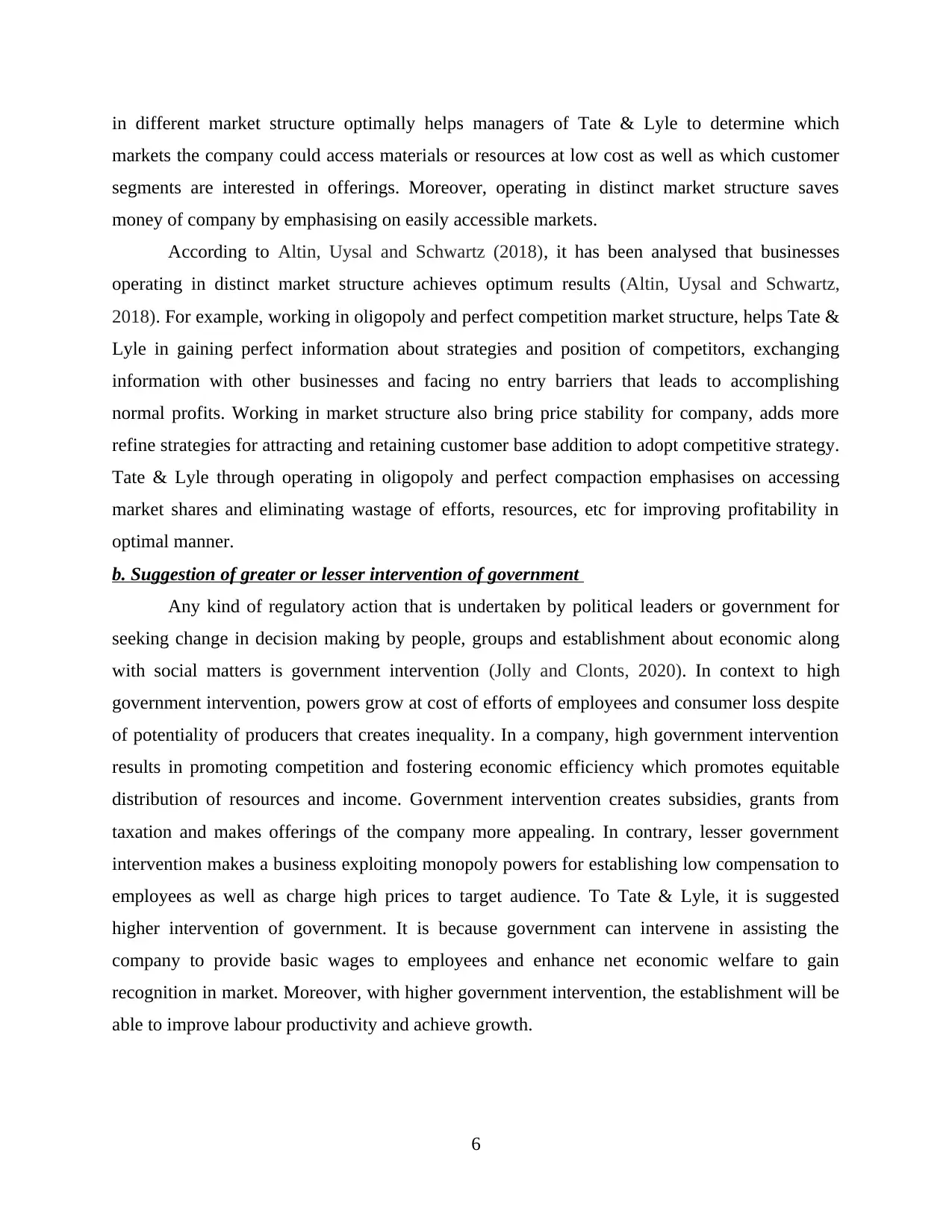
in different market structure optimally helps managers of Tate & Lyle to determine which
markets the company could access materials or resources at low cost as well as which customer
segments are interested in offerings. Moreover, operating in distinct market structure saves
money of company by emphasising on easily accessible markets.
According to Altin, Uysal and Schwartz (2018), it has been analysed that businesses
operating in distinct market structure achieves optimum results (Altin, Uysal and Schwartz,
2018). For example, working in oligopoly and perfect competition market structure, helps Tate &
Lyle in gaining perfect information about strategies and position of competitors, exchanging
information with other businesses and facing no entry barriers that leads to accomplishing
normal profits. Working in market structure also bring price stability for company, adds more
refine strategies for attracting and retaining customer base addition to adopt competitive strategy.
Tate & Lyle through operating in oligopoly and perfect compaction emphasises on accessing
market shares and eliminating wastage of efforts, resources, etc for improving profitability in
optimal manner.
b. Suggestion of greater or lesser intervention of government
Any kind of regulatory action that is undertaken by political leaders or government for
seeking change in decision making by people, groups and establishment about economic along
with social matters is government intervention (Jolly and Clonts, 2020). In context to high
government intervention, powers grow at cost of efforts of employees and consumer loss despite
of potentiality of producers that creates inequality. In a company, high government intervention
results in promoting competition and fostering economic efficiency which promotes equitable
distribution of resources and income. Government intervention creates subsidies, grants from
taxation and makes offerings of the company more appealing. In contrary, lesser government
intervention makes a business exploiting monopoly powers for establishing low compensation to
employees as well as charge high prices to target audience. To Tate & Lyle, it is suggested
higher intervention of government. It is because government can intervene in assisting the
company to provide basic wages to employees and enhance net economic welfare to gain
recognition in market. Moreover, with higher government intervention, the establishment will be
able to improve labour productivity and achieve growth.
6
markets the company could access materials or resources at low cost as well as which customer
segments are interested in offerings. Moreover, operating in distinct market structure saves
money of company by emphasising on easily accessible markets.
According to Altin, Uysal and Schwartz (2018), it has been analysed that businesses
operating in distinct market structure achieves optimum results (Altin, Uysal and Schwartz,
2018). For example, working in oligopoly and perfect competition market structure, helps Tate &
Lyle in gaining perfect information about strategies and position of competitors, exchanging
information with other businesses and facing no entry barriers that leads to accomplishing
normal profits. Working in market structure also bring price stability for company, adds more
refine strategies for attracting and retaining customer base addition to adopt competitive strategy.
Tate & Lyle through operating in oligopoly and perfect compaction emphasises on accessing
market shares and eliminating wastage of efforts, resources, etc for improving profitability in
optimal manner.
b. Suggestion of greater or lesser intervention of government
Any kind of regulatory action that is undertaken by political leaders or government for
seeking change in decision making by people, groups and establishment about economic along
with social matters is government intervention (Jolly and Clonts, 2020). In context to high
government intervention, powers grow at cost of efforts of employees and consumer loss despite
of potentiality of producers that creates inequality. In a company, high government intervention
results in promoting competition and fostering economic efficiency which promotes equitable
distribution of resources and income. Government intervention creates subsidies, grants from
taxation and makes offerings of the company more appealing. In contrary, lesser government
intervention makes a business exploiting monopoly powers for establishing low compensation to
employees as well as charge high prices to target audience. To Tate & Lyle, it is suggested
higher intervention of government. It is because government can intervene in assisting the
company to provide basic wages to employees and enhance net economic welfare to gain
recognition in market. Moreover, with higher government intervention, the establishment will be
able to improve labour productivity and achieve growth.
6
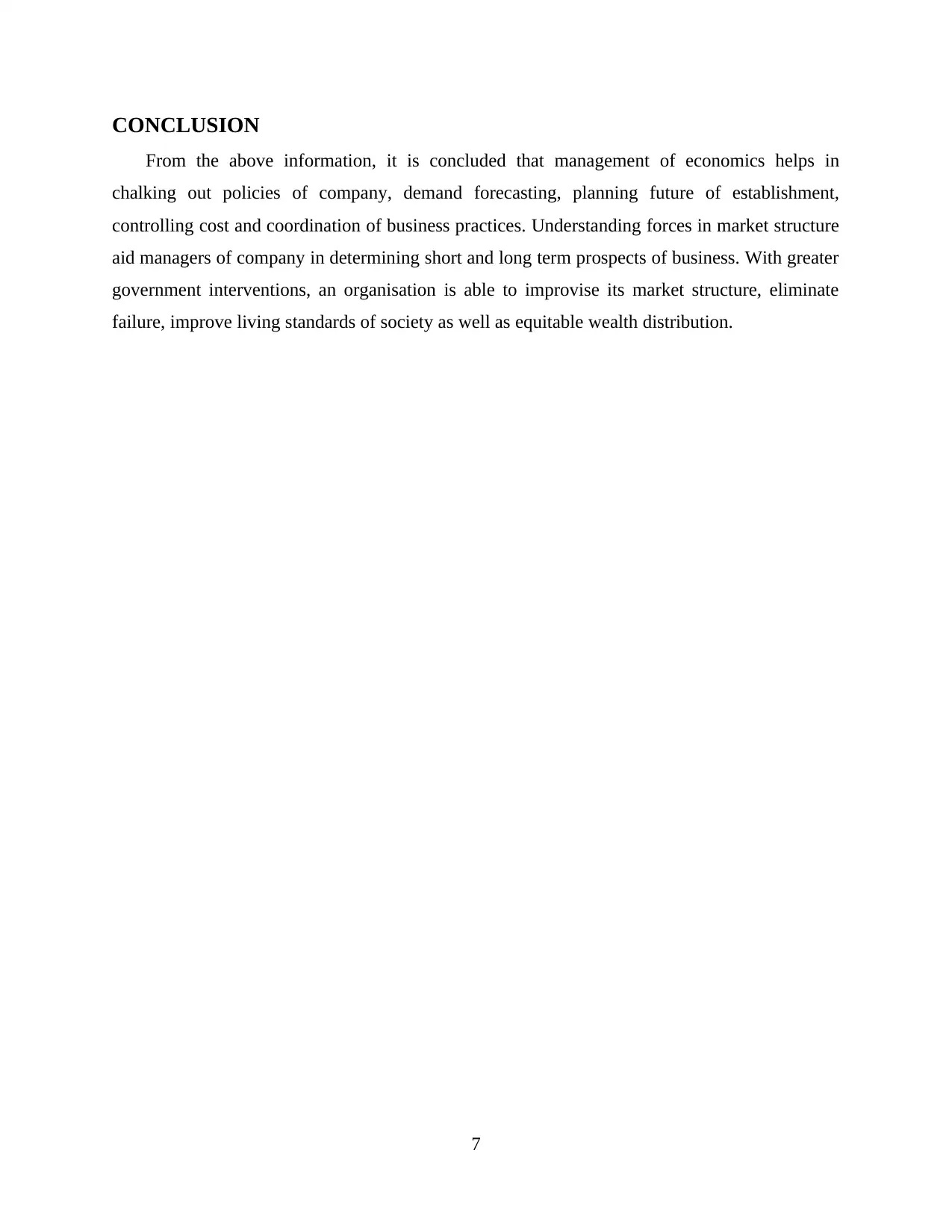
CONCLUSION
From the above information, it is concluded that management of economics helps in
chalking out policies of company, demand forecasting, planning future of establishment,
controlling cost and coordination of business practices. Understanding forces in market structure
aid managers of company in determining short and long term prospects of business. With greater
government interventions, an organisation is able to improvise its market structure, eliminate
failure, improve living standards of society as well as equitable wealth distribution.
7
From the above information, it is concluded that management of economics helps in
chalking out policies of company, demand forecasting, planning future of establishment,
controlling cost and coordination of business practices. Understanding forces in market structure
aid managers of company in determining short and long term prospects of business. With greater
government interventions, an organisation is able to improvise its market structure, eliminate
failure, improve living standards of society as well as equitable wealth distribution.
7
Secure Best Marks with AI Grader
Need help grading? Try our AI Grader for instant feedback on your assignments.
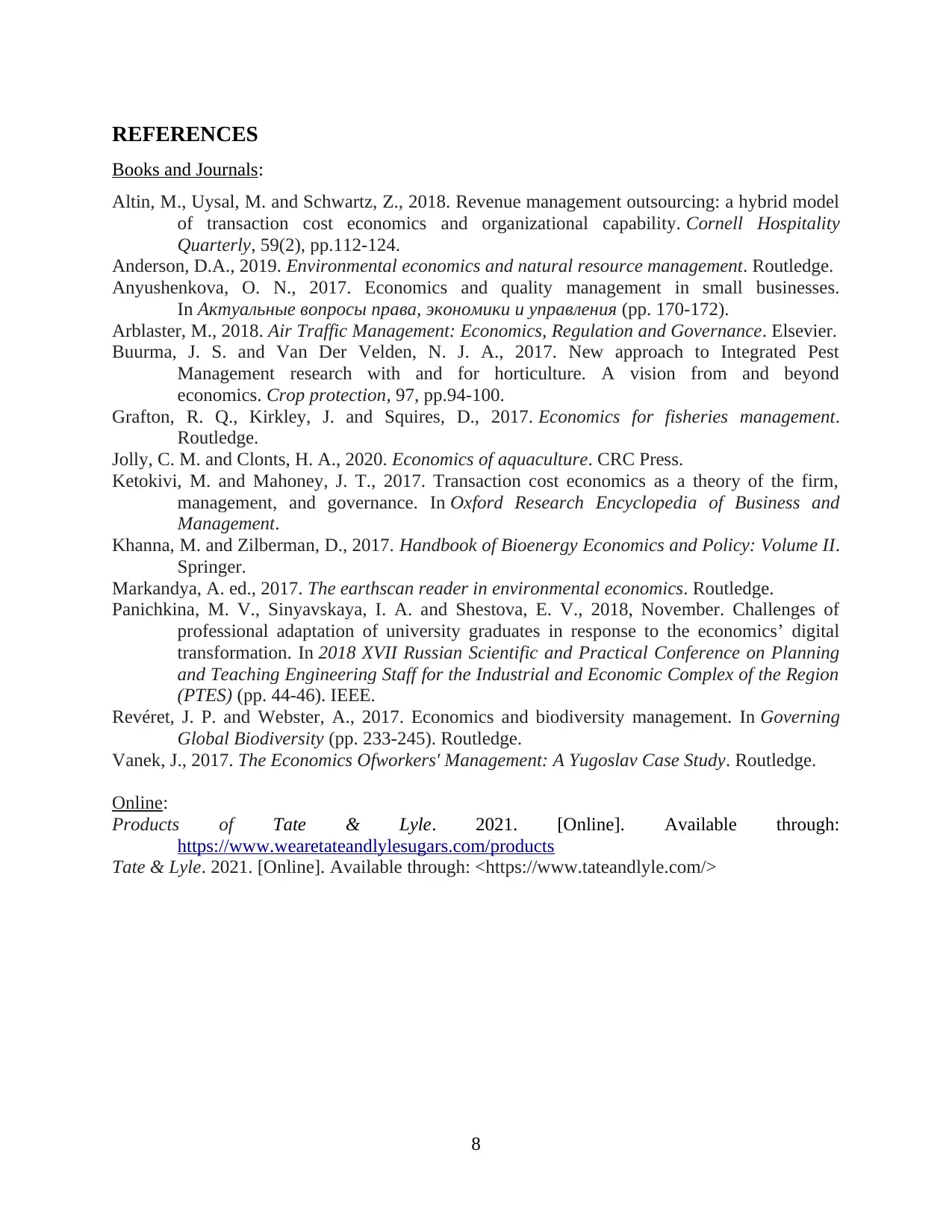
REFERENCES
Books and Journals:
Altin, M., Uysal, M. and Schwartz, Z., 2018. Revenue management outsourcing: a hybrid model
of transaction cost economics and organizational capability. Cornell Hospitality
Quarterly, 59(2), pp.112-124.
Anderson, D.A., 2019. Environmental economics and natural resource management. Routledge.
Anyushenkova, O. N., 2017. Economics and quality management in small businesses.
In Актуальные вопросы права, экономики и управления (pp. 170-172).
Arblaster, M., 2018. Air Traffic Management: Economics, Regulation and Governance. Elsevier.
Buurma, J. S. and Van Der Velden, N. J. A., 2017. New approach to Integrated Pest
Management research with and for horticulture. A vision from and beyond
economics. Crop protection, 97, pp.94-100.
Grafton, R. Q., Kirkley, J. and Squires, D., 2017. Economics for fisheries management.
Routledge.
Jolly, C. M. and Clonts, H. A., 2020. Economics of aquaculture. CRC Press.
Ketokivi, M. and Mahoney, J. T., 2017. Transaction cost economics as a theory of the firm,
management, and governance. In Oxford Research Encyclopedia of Business and
Management.
Khanna, M. and Zilberman, D., 2017. Handbook of Bioenergy Economics and Policy: Volume II.
Springer.
Markandya, A. ed., 2017. The earthscan reader in environmental economics. Routledge.
Panichkina, M. V., Sinyavskaya, I. A. and Shestova, E. V., 2018, November. Challenges of
professional adaptation of university graduates in response to the economics’ digital
transformation. In 2018 XVII Russian Scientific and Practical Conference on Planning
and Teaching Engineering Staff for the Industrial and Economic Complex of the Region
(PTES) (pp. 44-46). IEEE.
Revéret, J. P. and Webster, A., 2017. Economics and biodiversity management. In Governing
Global Biodiversity (pp. 233-245). Routledge.
Vanek, J., 2017. The Economics Ofworkers' Management: A Yugoslav Case Study. Routledge.
Online:
Products of Tate & Lyle. 2021. [Online]. Available through:
https://www.wearetateandlylesugars.com/products
Tate & Lyle. 2021. [Online]. Available through: <https://www.tateandlyle.com/>
8
Books and Journals:
Altin, M., Uysal, M. and Schwartz, Z., 2018. Revenue management outsourcing: a hybrid model
of transaction cost economics and organizational capability. Cornell Hospitality
Quarterly, 59(2), pp.112-124.
Anderson, D.A., 2019. Environmental economics and natural resource management. Routledge.
Anyushenkova, O. N., 2017. Economics and quality management in small businesses.
In Актуальные вопросы права, экономики и управления (pp. 170-172).
Arblaster, M., 2018. Air Traffic Management: Economics, Regulation and Governance. Elsevier.
Buurma, J. S. and Van Der Velden, N. J. A., 2017. New approach to Integrated Pest
Management research with and for horticulture. A vision from and beyond
economics. Crop protection, 97, pp.94-100.
Grafton, R. Q., Kirkley, J. and Squires, D., 2017. Economics for fisheries management.
Routledge.
Jolly, C. M. and Clonts, H. A., 2020. Economics of aquaculture. CRC Press.
Ketokivi, M. and Mahoney, J. T., 2017. Transaction cost economics as a theory of the firm,
management, and governance. In Oxford Research Encyclopedia of Business and
Management.
Khanna, M. and Zilberman, D., 2017. Handbook of Bioenergy Economics and Policy: Volume II.
Springer.
Markandya, A. ed., 2017. The earthscan reader in environmental economics. Routledge.
Panichkina, M. V., Sinyavskaya, I. A. and Shestova, E. V., 2018, November. Challenges of
professional adaptation of university graduates in response to the economics’ digital
transformation. In 2018 XVII Russian Scientific and Practical Conference on Planning
and Teaching Engineering Staff for the Industrial and Economic Complex of the Region
(PTES) (pp. 44-46). IEEE.
Revéret, J. P. and Webster, A., 2017. Economics and biodiversity management. In Governing
Global Biodiversity (pp. 233-245). Routledge.
Vanek, J., 2017. The Economics Ofworkers' Management: A Yugoslav Case Study. Routledge.
Online:
Products of Tate & Lyle. 2021. [Online]. Available through:
https://www.wearetateandlylesugars.com/products
Tate & Lyle. 2021. [Online]. Available through: <https://www.tateandlyle.com/>
8
1 out of 11
Related Documents
Your All-in-One AI-Powered Toolkit for Academic Success.
+13062052269
info@desklib.com
Available 24*7 on WhatsApp / Email
![[object Object]](/_next/static/media/star-bottom.7253800d.svg)
Unlock your academic potential
© 2024 | Zucol Services PVT LTD | All rights reserved.





